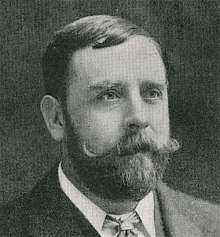
Frank Matcham was born in Newton Abbot, Devon, England on 22 November 1854. From c.1868 he trained with George Soudon Bridgman (1839-1925), an architect with a practice in Torquay, Devon. In c.1875 he moved to London and began working in the office of Jethro Thomas Robinson (1829-1878), an architect who specialised in theatre design. Following the death of Robinson in 1878 Matcham took over his practice and subsequently renamed the business Matcham & Co. Over the next three decades, Matcham and his firm were responsible for the design, redesign and refurbishment of over 150 theatres and entertainment venues throughout Britain. Much of this work was undertaken between the years 1892 and 1912 when he was closely associated with the Edinburgh-based theatre chain Moss Empires.
Shortly before World War One, Matcham retired to Westcliff-on-Sea in Essex where he died on 18 May 1920.
A biographical file on Frank Matcham is available on request from the Enquiry Desk, Royal Institute of British Architects Library, London
Notable among Matcham's works were the Grand Theatre in Islington (1882); The Paragon in Mile End, East London (1882); Everyman Theatre, Cheltenham (1891); Redecoration of the interior of The Tivoli, Strand, London (1891); Empire Palace Music Hall, Leeds, Yorkshire (1892); Empire Palace, Edinburgh (1894); Grand Opera House in Belfast (1894); Grand Theatre in Blackpool, (1894); Opera House in Wakefield (1894); Lyric Theatre, Hammersmith (1895); Empire, Langton (1895); Tivoli, Aberdeen (1896 and 1909); Richmond Theatre, Surrey (1899); London Hippodrome, (1899-1900); Gaiety, Douglas, Isle of Man (1900); Hackney Empire, London (1901); Hippodrome in Brighton (1901); Auditorium of The Empire, Newcastle-upon-Tyne (1901); Opera House, Buxton, Derbyshire (1903); Devonshire Park Theatre in Eastbourne (1903); Shepherd's Bush Empire, London (1903); Royal Hall in Harrogate (1903); King's Theatre, Glasgow (1904); the London Coliseum (1904); Olympia Theatre, Liverpool (1905); King's, Southsea (1907); His Majesty's in Aberdeen (1909); Olympia in Liverpool (1909); London Palladium (1910); the Victoria Palace, London (1911); Wood Green Empire in Wood Green, Haringey, London (1912); and Hippodrome, Bristol (1912)
_____
See also:
Band, Barry. Matcham's Masterpiece: A brief history of Blackpool's Grand Theatre - Designed by Frank Matcham, 1894. With Star Parade and Highlights. Blackpool: Barry Band, 2005
Billington, Michael. ‘How we miss Matcham's matchless beauties’. Country Life vol. 215, no. 27, 1 July 2020 pp. 166-167.
Directory of British Architects 1834-1914. Compiled by Antonia Brodie, et al. Volume 2: L-Z. London; New York: British Architectural Library, Royal Institute of British Architects/Continuum, 2001
Frank Matcham, theatre architect. Edited by Brian Mercer Walker. Belfast: Blackstaff Press, 1980
Gray, A. Stuart. Edwardian architecture: a biographical dictionary. London: Gerald Duckworth & Co., Ltd., 1985
Griffin, Kate. ‘Matchless Matcham’. [Buxton Opera House, designed by Frank Matcham in 1903] SPAB magazine Autumn 2020 pp. 72-73
Jones, Griff Rhys; Grieve, James; and Price, Mark. ‘Theatres in the spoitlight’. Victorianno. 69, March 2022 pp. 4-12
McCarthy, Sean. ‘Frank Matcham's early career (part 1)’ Theatre Notebook vol. 25, no. 3, Spring 1971 pp. 103-108.
McCarthy, Sean. ‘Frank Matcham's early career (part 2)’ Theatre Notebook vol. 25, no. 4, Summer 1971 pp. 152-157.
Read, Jack. Empires Hippodromes & Palaces. London: Alderman Press, 1985
Wilmore, David. Frank Matcham and Co. Dacre,Yorkshire: Theatresearch, 2008
‘Obituary’. The Builder vol. 118, 28 May 1920 p. 629
‘Who was Frank Matcham?’ RIBA Journal vol. 111, no. 2, February 2004 p. 9